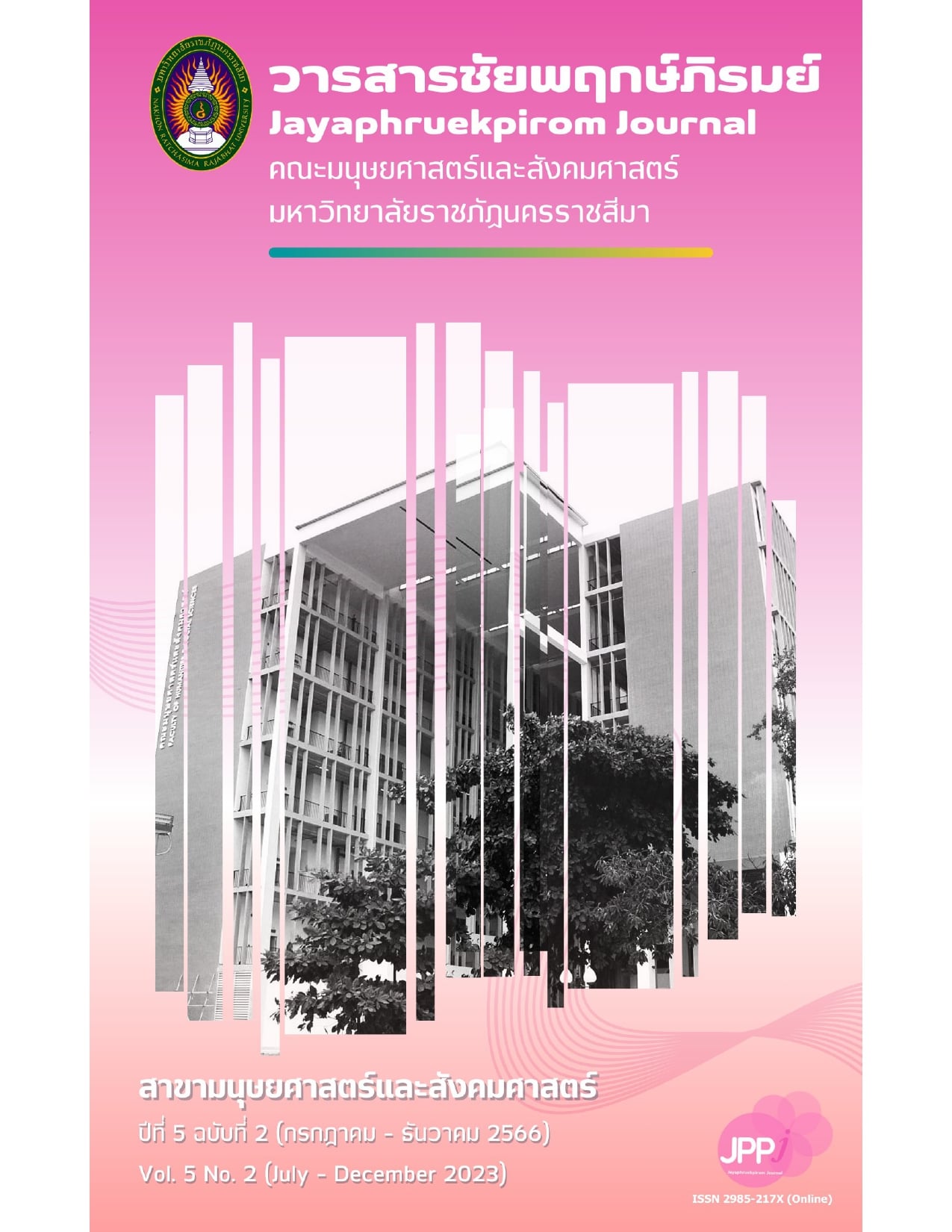THE DEVELOPMENT OF MAPS FOR ELECTRONIC LEARNING RESOURCES IN THE ARTS CULTURE AND TRADTION
Keywords:
Electronic Learning Center, Thai-Yuan, Culture and TraditionAbstract
The research on "The Development of Maps for Electronic Learning Resources in the Arts Culture and Tradition aimed to 1. Study the community context related to arts, culture and traditions of Thai-Yuan Village, Sikhio District, Nakhon Ratchasima Province and 2. Develop an electronic map of learning resources in art, culture, and tradition of Thai-Yuan Village, Sikhio District, Nakhon Ratchasima Province. The tools used for collecting data were interviewing form and 5-scale questionnaire. The data were analyzed by frequency, mean, and percentage. The results of the research revealed that the community context information related to art, culture, and tradition of Tai-Yuan Village, Sikhio District, Nakhon Ratchasima Province having remained and still inherited until today include the Mahachat Sermon festival, the Kan Lorn parade, Kao Yakoo making tradition, Tan Guay Salak Tradition, Tan Khan Kao Tradition, Poy Kao Sang Tradition, and the homage-paying ceremony for Phraya Si Khio. And, for the development of the map of electronic learning resources to be a source of learning about art, culture, and tradition of Tai-Yuan Village, Sikhio District, Nakhon Ratchasima Province, the map of the electronic learning was create with GIS programs. Additionally, the information about art, culture, and tradition of Tai-Yuan Village, Sikhio District, Nakhon Ratchasima Province was recorded as a video clip inserted into the map using a QR Code to scan and read the content of art, culture, and traditions of the Tai-Yuan people with introduction presented and used with the group of 30 samples. The result of the satisfaction assessment of the use of the map was found that the samples were satisfied with the map in terms of having learning materials at the highest level (= 4.67 S.D. = .47), the samples were satisfied with the overall composition which was nice and had complete content at the highest level ( = 4.50 S.D. = .57), the samples were satisfied with the benefit of the use of content, the supportive content for useful decision, and the appropriateness of the letters at the high level ( = 4.47 S.D. = .50, 57), and the samples were satisfied with the design of the media as being modern and easy to understand at the high level ( = 4.43 S.D. = .50, .56)
References
กรมสามัญศึกษา. กระทรวงศึกษาธิการ. (2544). การพัฒนาห้องสมุดโรงเรียนให้เป็นแหล่งเรียนรู้ในโรงเรียนและ
ท้องถิ่นเพื่อจัดกระบวนการเรียนรู้. กรุงเทพฯ: กระทรวงศึกษาธิการ.
กิ่งแก้ว อารีรักษ์ และคณะ. (2548). การจัดการห้องเรียนและแหล่งเรียนรู้. กรุงเทพฯ: มีนเซอร์วิส ซัพพลาย.
โกมาตร จึงเสถียรทรัพย์, คณิศร เต็งรัง, ราตรี ปิ่นแก้ว และวรัญญา เพ็ชรคง. (2545). คู่มือการเรียนรู้ที่ทำให้
งานชุมชนง่าย ได้ผลและสนุก. นนทบุรี: สถาบันวิจัยระบบสาธารณสุข,
_______. (2559). วิถีชุมชนเครื่องมือ 7 ชิ้น ที่ทำให้งานชุมชนง่าย ได้ผล และสนุก (พิมพ์ครั้งที่ 12). นนทบุรี:
สุขศาลา.
จารุวรรณ พรมวังขำเพชร. (2537). วิถีครอบครัวและชุมชน ชาวไทยวนสีคิ้ว จ.นครราชสีมา. กรุงเทพฯ:
สำนักงานคณะกรรมการวัฒนธรรมแห่งชาติ.
ชุติรัตน์ เจริญสุขและอาคม เจริญสุข. (2560). การพัฒนาผลิตภัณฑ์การท่องเที่ยวเชิงวัฒนธรรมไท-ยวน
ชุมชนบ้านนาขุนแสน อำเภอสวนผึ้ง จังหวัดราชบุรี. สืบค้นเมื่อ 25 กุมภาพันธ์ 2565 จาก
file:///C:/Users/HP/Downloads/cover%20in.pdf
ชุมพล รอดแจ่ม. (2555). เส้นทางการท่องเที่ยวเชิงศิลปวัฒนธรรม อำเภอบางกรวย จังหวัดนนทบุรี. สืบค้นเมื่อ
ธันวาคม 2563, จาก http://www.rpu.ac.th/Library_web/doc/RC_RR/2555_
Account_Chumpon.pdf
ชูศรี วงศ์รัตนะ. (2550). เทคนิคการใช้สถิติเพื่อการวิจัย (พิมพ์ครั้งที่ 10). กรุงเทพฯ: ศูนย์หนังสือแห่งจุฬาลงกรณ์มหาวิทยาลัย.
ดำริ บุญชู. (2548). การใช้ประโยชน์จากแหล่งเรียนรู้ในสถานศึกษา. วารสารวิชาการ, 8(1), น. 27-31.
ธเนศ ศรพรหม. (2561). การพัฒนาแผนที่อิเล็กทรอนิกส์แบบปฏิสัมพันธ์เพื่อประชาสัมพันธ์แหล่งท่องเที่ยว 9 วัดของจังหวัดอุบลราชธานี. สืบค้นเมื่อ 5 กุมภาพันธ์ 2564, จาก http://www.graduate.ubru.ac.th/ubru-journal/assets/onlinefile/1548059254.pdf
นาวา วงษ์พรม. (2560). แหล่งการเรียนรู้ในชุมชน. อุดรธานี: มหาวิทยาลัยราชภัฏอุดรธานี.
บริษัท คาร์แทรค เทคโนโลยี (ไทยแลนด์)จำกัด. (ม.ป.ป.) แผนที่นำทาง ด้วยระบบ GPS สิ่งจำเป็นคู่นักเดินทาง.
สืบค้นเมื่อ 28 พฤศจิกายน จาก https://www.cartrack.co.th/blog/aephnthiinamthaang-
dwyrabb-gps-singcchamepnkhuunakedinthaang
ปริยาภรณ์ ตั้งคุณานันท์. (2557). การจัดการห้องเรียนและแหล่งเรียนรู้ = Classroom and learning
resource management. กรุงเทพฯ: มีน เซอร์วิส ซัพพลาย.
ปรีดาพร ไวทยการ. (2554). การออกแบบแผนที่ชุมชนเชิงวัฒนธรรม : การศึกษาความสัมพันธ์ของมิติเวลาและ วิถีชีวิตชุมชนกาดหลวง จังหวัดเชียงใหม่. สืบค้นเมื่อ 10 ธันวาคม 2563, จาก http://cmuir.cmu.ac.th/bitstream/6653943832/28280/2/mdad20954pv_abs.pdf
แผนที่ (ม.ป.ป.) สืบค้นเมื่อ 25 พฤสจิกายน 2565 จาก http://www.digitalschool.club/digitalschool/social1_1_1/social3_5/lesson5_1/page1.php
สำนักงานคณะกรรมการการศึกษาขั้นพื้นฐาน. (2547). การใช้แหล่งการเรียนรู้ในโรงเรียนและชุมชน.
กรุงเทพฯ: สำนักงานคณะกรรมการการศึกษาขั้นพื้นฐาน.
สุมาลี สังข์ศรี และคณะ. (2548). การจัดการเรียนรู้ของแหล่งการเรียนรู้ตลอดชีวิต : พิพิธภัณฑ์ (รายงานการวิจัย). กรุงเทพฯ: สำนักงานเลขาธิการสภาการศึกษา.
สุวิมล อิษฎากร. (2553). การศึกษาการอนุรักษ์ภูมิปัญญาท้องถิ่นผ้าทอไท-ยวน : กรณีศึกษาบ้านโนนกุ่ม
หมู่ที่ 2 .ตำบลมิตรภาพ อำเภอสีคิ้ว จังหวัดนครราชสีมา. (วิทยานิพนธ์มหาบัณฑิต, มหาวิทยาลัยราชภัฏ
นครราชสีมา)


